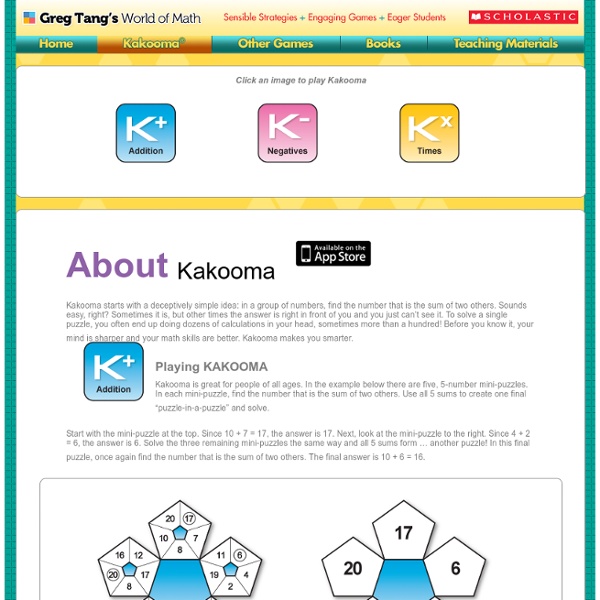Mathway: Math Problem Solver
XtraMath
Jeu de go interactif
A to Z Kids Stuff | China
Do not want others to know what you have done? Better not have done it anyways. -Chinese Proverb Ch'in (Qin) (221BCE-206BCE) During the Qin dynasty, all of China was united and the Great Wall of China was begun. Qin Shihuangti was the first emperor of China. In 1974, Emperor Qin Shihuang's tomb was discovered, it included 6,000 terra cotta army figures. Genghis Khan The achievements of Genghis Khan were grandiose.
Documento sin título
Justificación y Breve descripción del programa: De todos es sabido que en cualquier clase y en todas las Áreas encontramos niveles, ritmos y modalidades de aprendizaje muy diferentes entre nuestro alumnado. También debemos asumir que, el derecho que todos los niños y niñas tienen a recibir una educación de calidad, y el deber que tenemos los profesionales de la Enseñanza de proporcionársela, requiere que seamos capaces de atender a esa enorme Diversidad que tenemos en nuestras aulas. Para ello es necesario buscar y utilizar todas las estrategias, recursos y materiales en general que tengamos a nuestro alcance. Uno de estos recursos es sin duda alguna el Ordenador. Por todo ello, se propone este Programa: “Refuerza y Amplía tus Matemáticas”, que permite tratar a nuestro alumnado de una forma completamente personalizada, respetando sus ritmos y capacidades individuales. Se divide en dos grandes Áreas: Cálculo y Problemas: Requerimientos mínimos: Instrucciones de funcionamiento: · Menú. · Resumen.
CALCULATORS
Math Chimp Blog | Educational Games and Online Resources
While they are in 5th grade, some of them are not capable of teaching themselves to take on math, as noted by The Globe and Mail. For teachers, what makes the situation worse is that most students suffer from “Math Block,” wherein they develop a passive attitude towards the subject. Fortunately, mobile technology and gamification are here to save the day. In fact, Verizon notes that turning math lessons into games gives students the motivation and energy to master any subject. 1. Factor Samurai employs the similar gameplay of Fruit Ninja, while educating kids the basics of prime factorization. 2. According to the app description, Match Up Math helps students practice the four fundamental operations: Multiplication, Division, Addition, and Subtraction. 3. While teaching fractions and decimals, Chicken Coop Fractions injects an entertaining approach, as two chickens named Henriette and Gudhen fire eggs at the number line. 4. 5. 5th Grade Splash Math Worksheets Game About the Author
La Chine et ses campagnes
1Au début du mois d’octobre 2005, lors de la cinquième session plénière du XVIe Comité central, le Parti communiste chinois a officiellement adopté le 11e plan quinquennal (2006-2010) au cours duquel il appelle à l’« édification de nouvelles campagnes socialistes (jianshe shehui zhuyi xin nongcun) ». Cette nouvelle politique à destination des campagnes, où vivent encore 750 millions de Chinois, a pour objectif principal de résoudre les différents maux qui accablent une grande partie du monde rural depuis maintenant près d’une quinzaine d’années. Après avoir placé les campagnes au centre des premières réformes, les autorités chinoises se sont ensuite penchées sur le développement des villes, reléguant les questions rurales au second plan. 3Cet article n’a pas pour objectif d’esquisser un portrait de l’agriculture chinoise. 1 On trouvera des descriptions et des analyses détaillées de ces épisodes de l’histoire rurale chin (...) 3 Ibid. 4 Thierry Sanjuan, op. cit., p. 144. Carte 1 Carte 2
Mars As Art - Mars Exploration Program
Multimedia > Mars As Art
USEFUL SITES
Algebra - Elementary Algebra - Homework Help
Can I take a course at HippoCampus for credit? How do I enroll in a course at HippoCampus? Are there any fees to take your courses? How do I make a comment or ask a question? How do I get individual help with my homework assignment? What are the preferred texts? How can I use HippoCampus in my classroom? How can I use HippoCampus in my home school? Can I use the resources you have available for my homeschoolers? Do you know of any wet lab resources to accompany HippoCampus content? Is there a script, app, or something that can be used to track student use of HippoCampus? Can I share my HippoCampus content with my fellow teachers? Can I download the video? Can I change the size of the video window? Why won't the Environmental Science animations play? What if my page scroll bars or "submit" button are not showing? I can't find closed captioning. Where does the content from your site come from? There is an error in the multimedia presentation. How do I report a course errata item? No. AP Course Ledger
La pyramide des besoins de Maslow d’un point de vue pédagogique | madamemarieeve
Le psychologue Abraham Maslow a établi une hiérarchie des besoins en faisant des recherches sur la motivation. Il a ainsi réalisé, dans les années 1940, la pyramide des besoins. Le fonctionnement doit être perçu tel un escalier. L’individu doit satisfaire les besoins qui sont à la base afin de pouvoir réaliser ceux qui sont au niveau supérieur. Le plus haut niveau étant le besoin de s’épanouir. Voici l’explication de chacun des niveaux. Besoins physiologiques: Ils sont liés à la survie. Besoin de sécurité : Ce besoin se réfère au fait que tout individu doit se protéger des dangers. Besoin d’appartenance et affectif : Ce besoin a une dimension sociale. Besoin d’estime : Il est le prolongement du besoin précédent. Besoin de s’épanouir : Ce besoin se retrouve au sommet des aspirations humaines. Nous devons tenir compte, en tant qu’enseignant, de ces besoins. Voilà donc la pyramide vue sous un regard ayant une vision pédagogique: N’est ce pas l’objectif premier d’un enseignant? J’aime ça :



